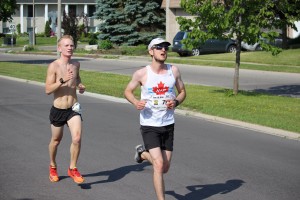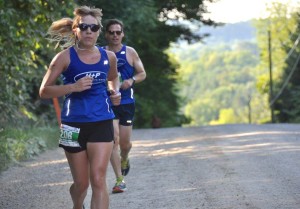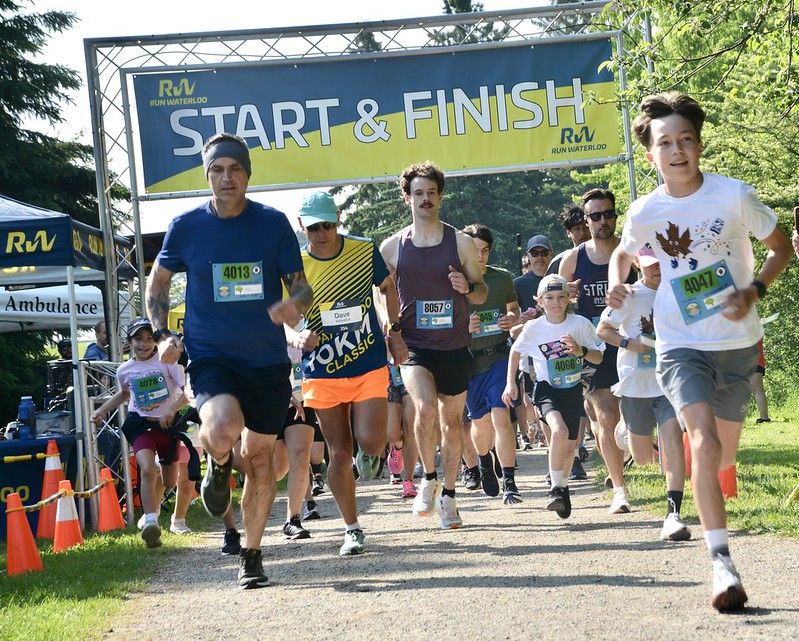Well, it’s safe to say that the hot summer days of running are here! With many big races on the horizon, including the Waterloo Classic, it’s important to make sure we do our best to prepare for the additional challenge heat provides.
It’s a topic I wrote about briefly in the past, but this week I wanted to take a closer look at things. Two strategies I discussed before were (1) getting acclimated to the heat and (2) pre-cooling.
Both of these strategies make sense logically. If you practice running in the heat, your body will be better equipped to handle it. In the case of pre-cooling, if you start with a cooler body temperature, then there is more wiggle room before your body really has to make the push to cool off. But what does the research show, and how well does each strategy work?
Take for instance this new study published in 2017 in the Journal of Strength and Conditioning:
In the study, athletes were put through a 5K TT test at 32°C with 60% relative humidity; it was HOT. This time trial was conducted under 4 different protocols:
- With no heat training intervention
- With short-term heat acclimation (runs taking place in the heat 5 days before the TT)
- Pre-cooling (runners were kept cool before the TT)
- Combined heat acclimation and pre-cooling
After conducting the trials, this is what they found:
- All runners who did something to cope with the heat showed an increase in performance. These strategies work.
- The pre-cooling group showed a 3.7% improvement.
- The heat acclimation group showed a 6.6% improvement.
- The heat acclimation + pre-cooling group showed a 7.0% improvement.
So it’s clear; the best way to perform well in the heat is to spend time running in the heat in close proximity to that event. A 6.6% boost in performance is massive. For a 20minute 5K, that’s a difference of just under 1.5 minutes!
Another interesting thing to note is that when pre-cooling is added to heat acclimation, there is no statistical advantage to heat acclimation on it’s own. By contrast, pre-cooling in the absence of heat acclimation provides a 3.7% improvement in 5K TT performance.
 It seems that if your body is fully trained and ready to perform in the heat, then its ability to control temperature will outperform and therefore not benefit from a the small boost provided by pre-cooling. So, use pre-cooling in full force if you have not had the chance to undergo any heat acclimation!
It seems that if your body is fully trained and ready to perform in the heat, then its ability to control temperature will outperform and therefore not benefit from a the small boost provided by pre-cooling. So, use pre-cooling in full force if you have not had the chance to undergo any heat acclimation!
Is it still smart to pre-cool even if you have acclimated to the heat? Despite these numbers, I still say yes! Firstly, despite your best efforts, you may not be fully acclimated, so the pre-cooling may still help. Secondly, despite there not being a statistical difference, the researchers did see increased signs of “physiological strain” when pre-cooling was not used in addition to heat acclimation. As we have seen in the past, if something impacts the mind, it can impact how fast we run. Even if you have undergone heat acclimation, starting a race feeling cool and ready to hammer will undoubtedly help your psychology while also likely having positive influences on your physiology not fully revealed by this study.
Practical applications:
So how do you apply this?
Pre-Cool: In the hours leading up to your race, and after your warm up jog, use strategies such as cold showers, wrapping yourself in ice cold/wet blankets, and pouring cold water bottles over your head to make sure your body is starting as cool as possible leading into the race.
Short-term heat acclimation: From a heat acclimation standpoint, in the 1-2 weeks leading up to your big race, make sure to do many of your runs in the heat! If you are tapering, the running volume should be lower, so these efforts will be much more manageable. Paying the price of some heat related pain now will pay dividends (of up to 6.6% on race day!).
Long-term heat training: From a long-term standpoint, I definitely think it’s smart to use a combination of training in the heat vs. cooler locations/times of day to optimize performance. A good strategy, when far away from a key race (further than 4-6weeks away), would be to do your key quality sessions in a cooler environment. Heat without a doubt takes away from your ability to push your high-end pace, which would limit some of the muscular and cardiovascular adaptations that are triggered when you push your limit.
However, opting do your easy runs in the heat not only helps you to perform better in the heat, but there is even is a body of evidence out there showing that it could improve your performance in cooler races. I’ve written about this subject in the past HERE, where an increase in blood volume due to an increase in fluid retention results in enhanced blood transport.
Moderate-term heat training: Finally, as you approach your important race (4-6 weeks out), I advise adding in a mix of quality sessions in the heat. If you conduct two quality runs/week, doing one in the heat and one in cooler temperatures to reap the benefits of both ends of the spectrum would be a reasonable approach to take. We always do our best to implement this approach at H+P as we have key track sessions early in the cooler mornings, complemented by grinding hard hill workouts in the early evenings.
I hope this helps you successfully tackle the heat! Another important part to racing in the heat is accepting a slower goal pace. Some may adapt better than others, but nobody can run at their best when it’s over 30°C! And as always, when you’re racing in high temperatures, if you start feeling nauseous or dizzy, or notice any other signs of not coping with the heat beyond normal exertion, simply slow down or drop out so you can live to fight another day!






